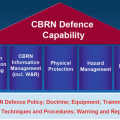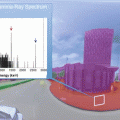Radionuclide
Half life
Particle emission
Polonium (Po210 84)
138.4 days
α of 5.31 MeV and γ of 0.8 MeV
Radium (Ra226 88)
1,600 years
α of 4.78 MeV and γ of 0.6 MeV
Plutonium (Pu238 94)
86.4 years
α of 5.50 MeV and γ of 1.1 MeV
Americium (Am241 95)
433 years
α of 5.49 MeV and γ of 0.8 MeV
Strontium (Sr90 38)
28.1 years
ß of 0.5 MeV
Iodine (I131 53)
8.0 days
ß of 0.6 MeV and γ of 0.6 MeV
Caesium (Cs137 55)
30.0 years
ß of 1.2 MeV and γ of 0.6 MeV
Iridium (Ir192 77)
74 days
ß of 0.7 MeV and γ of 0.6 MeV
Cobalt (Co60 27)
5.3 years
ß of 0.3 MeV and γ of 1.3 MeV.
Both the efficiency of the dirty bomb and its radioactive contamination level would depend on the chemical explosive used and the radiological toxicity of the material. The higher the destruction capacity of the chemical explosive, the more effective the scattering of the radioactive material will be. Nuclear forensics are being developed to analyse the attribution of radioactive materials to find out clues to their original source. This scientific area is of great importance if we take into account the number of radioactive materials that can be found in the black market trade.
12.3 Traumatic and Psychological Effects of Radiological Terrorism
The main purpose of a dirty bomb is to cause chaos, mass panic and traumatic and post-traumatic psychological-psychogenic effects in the population. In addition to these effects, terrorists might consider the economic losses and the costs of decontamination that would follow to this type of attack. The explosion of an RDD could contaminate water supply, food and other consumer articles, thus causing a great alarm and social disruption.
Although RDDs were discarded as military tactical weapons, they could be of great interest to terrorists because of the above reasons. Decontaminating the affected area could cost from a few million Euros up to several hundred million Euros, the cost depending on the category of the radioactive material [25]. During the expansion of the radioactive cloud, the radionuclides can be inhaled, ingested, deposited on the skin of people found in the cloud expansion area. In the case of explosion of a dirty bomb the number of victims, both those physiologically and psychologically injured, would create a complex and difficult task for hospital logistics.
The treatment of casualties of radiological accidents is extremely varied and complex. They must be cared in hospitals by staff who are engaged in a daily basis in the haematological, chemotherapeutic, radiotherapeutic and surgical treatment of patients at risk from cancer, immunosupression and blood dyscrasias (The Radiological Accident in Goiania 1988).
Up to now, research made to assess the psychological effects caused by the explosion of an RDD is mainly based on experiential cases from incidents related to nuclear power plants such as Three Mile Island (1979, USA) and Chernobyl (1986, USSR). With respect to radioactivity, because of disinformation or, more important, because of the manipulated information of some sensationalist mass media, people generally have a deep fear. The accident occurred at Fukushima Daiichi nuclear power plant as a consequence of the devastating tsunami that struck Japan on March 11, 2011, put into account that social impact around the world was not derived from real facts, but from the way several mass media, antinuclear groups and irresponsible entities transmitted the events. The spreading of false news describing apocalyptic scenarios produced a great level of stress in Japanese population.
Psychological impact of a person exposed to radiation could result in severe psychological effects due to the psychosis produced by a magnified impression of the risk. If we take into account that fear perception is produced through a complex process of cognitive, behavioural, emotional and psychological factors, in the case of an RDD explosion these factors would be notoriously increased. The sarin gas terrorist attack in Tokyo subway (Japan) in 1995 can be considered as a paradigm of a terrorist attack to population with chemical warfare agents. After the attack, a great deal of the approximately 5,500 persons that went to 280 medical centres in Tokyo were citizens that, either did not suffer gas exposure harm or were not genuinely affected, but were afraid to become ill [18].
An incident involving radioactive agents happened in London when Mr. Alexander V. Litvinenko reportedly died from radioactive Polonium-210 poisoning in the intensive care unit of the University College Hospital in London on November 23, 2006. By November 26, 2006 “hundreds of people contacted the NHS [National Health Service] direct hotline to seek advice about potential radiation poisoning”. “By December 4, more than 3,000 persons had phoned the British Health Protection Agency” [22]. Following the death of Alexander Litvinenko, the Health Public Agency (HPA) organized 24 monitoring teams from the Division of Radiological Protection to measure the level of exposure to Po-210 by people who may have been in places where supposedly occurred the incident and other places. According to Bailey et al. [2]:
The alleged poisoning of Mr Alexander Litvinenko with polonium-210 was an extraordinary event that presented some unique public health challenges. Environmental polonium-210 contamination was found at a number of locations in London, including parts of two hospitals, several hotels, restaurants, and office buildings. […] Urine samples from 753 people were processed: about 500 during the first month, another 250 up to the end of May 2007, and a further three up to August 2007
The hypochondriasis factor was also studied after the Polonium-210 incident, and research by Morgan et al. [16] put into account that “Providing reassuring messages during a public health incident may be ineffective for individuals with high health anxiety”.
It is therefore of utmost importance to develop a proactive communication policy to adequately inform the population. Credibility is an essential factor to mitigate the uncertainty and alleviate the psychological impact in the potential case of an RDD explosion.
12.4 Code Systems to Calculate the Effects of an RDD Explosion
Radioactive doses produced in the explosion of an RDD have been calculated by means of experimental tests and mathematical code systems. Some of these code systems have been originally developed for potential accidents in nuclear power plants and are being implemented in several countries to calculate the effects produced by an RDD explosion. Local weather data and the activity of the radioactive source are used as initial references to calculate the inhalation, groundshine doses and cloudshine doses received by people at the area surrounding the explosion. Some of these code systems are:
HOTSPOT, developed by the US Lawrence Livermore National Laboratory, [11].
HPAC (Hazard Prediction and Assessment Capability), developed by the US Defense Threat Reduction Agency [9, 10].
RODOS (JRODOS) (Real-time On-line DecisiOn Support), developed under the auspices of the Framework Programs of the European Commission [19].
LASAIR (Lagragian Simulation of Dispersion and Inhalation of Radionuclides), conducted by the German Federal Office for Radiation Protection [26].
The three first codes are based on the Gaussian algorithm whereas the LASAIR code uses the Lagrange algorithm and is used to follow up on local atmospheric variations after an explosion. The prototype version of the RODOS code includes both algorithms. If we compare these code systems under the same initial conditions analogous results are obtained from a downwind distance of about 700 m. At inferior downwind distances, the RODOS code system obtains lower inhalation doses.
HOTSPOT is a model that provides fast results and that is easy to use. It is not applicable in areas with complex topography and weather. The data input is limited to a fixed windspeed and direction and atmospheric stability in fields, which vary from 0.1 to 1.0 m. Output data are limited to inhalation doses because they are several orders of magnitude superior to the groundshine doses. HOTSPOT considers that only 10 % of the radioactive material from an RDD is dispersed as particles with a diameter of less than 1 μm that could produce lethal effects with a bigger probability.
HPAC considers complex topography and simulates building structures. This code system also includes all radioactive decay and daughter isotopes of the radioactive materials produced by the RDD from the exact moment of the explosion. When comparing the HPAC and HOTSPOT models for a similar scenario, apart from their own characteristics, HOTSPOT needs 15–30 s to obtain the doses, and HPAC requires 1–2 min.
The RODOS code system is flexible and can transmit the obtained results in real-time to European Union countries. This system uses weather forecast data provided in real-time by regional and national weather services as inputs. The inputs also include statistical data on the population and agricultural and cattle production. Hydrological data from rivers and lakes are also included. The output consists of radionuclide deposition up to distances of approximately 80 km, individual doses from external and internal exposure, and countermeasures such as sheltering, evacuation, relocation, decontamination and food and water control. Administering iodine tablets to counteract I-131 in the thyroid gland is also another countermeasure taken into account. The RODOS prototype version, PRTY-40, combines Eulerian and Lagrangian algorithms and includes abrupt terrains and meteorological dispersion in its input data. The most characteristic output data from RODOS are the calculation of individual radiological doses and the countermeasures that must be applied. These output data and countermeasures can be transmitted in real-time to European Union countries [20]. The above code systems are implemented in a regular time basis.
Stay updated, free articles. Join our Telegram channel

Full access? Get Clinical Tree






